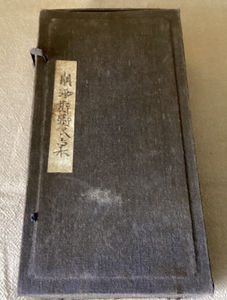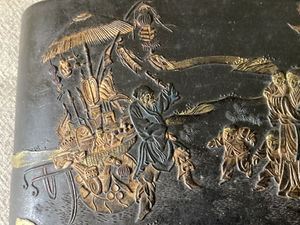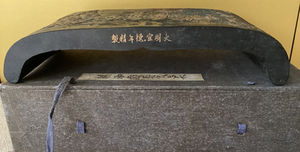Create Your First Project
Start adding your projects to your portfolio. Click on "Manage Projects" to get started
Chinese Antique Ink Stick / Cake Table Stand
CHINESE ANTIQUE INK STICK / CAKE STAND
砚Scholars Studio
文房四寶: 筆、墨、紙、硯
A RARE COLLECTORS TREASURE FOR THE SCHOLARS
STUDIO
QING DYNASTY (1644-1911)
An outstanding rare shaped stand for the scholars treasure.
A itinerant seller, his two wheeled art, gowned ladies, young children playing, pine and plantain trees, rockery.
The reverse with calligraphy and seal marks.
The calligraphy on one side of the stand reads "Cheng Junfang Ink"
Opposite side reads “Da Ming Xuande Jingzhi”, Ming Dynasty Xuandi Period. (1426 to 1435 )
Condition : Ink Stick /cake, no breaks , very good for age. Gilding age faded. Original Box : Age Faded & Stained.
Refer the large images for details & condition.
Please Note... depending on your computer monitor / phone / ipad etc. colour may vary to actual.
Outer Box
Length about 26cm
Width about 23.3 cm
Depth about 6.3 cm
Stand :
Length about 22.2 cm
Width about 10.4 cm
Height about 4.5 cm
A$495
Over the course of the early centuries there developed in China a special tradition regarding the paraphernalia of the study, which includes all the cherished objects literati and artists always have near at hand.
Paper and writing brush, ink cake and ink slab— referred to as Wen-Fang-Szu-Pao (The Four Treasures of the Study)— conform to certain conventional patterns, [although] tradition leaves ample scope for individual artistic expression.
The tradition was kept alive by the desire of scholars and artists to surround themselves with beautiful things; there can be no doubt, however, that it originated from magic considerations.
Almost every one of the objects suggests by its shape or material that it is a receptacle of ‘vital essence” (R.H. van Gulik).
In practice, the ink cake is ground with water on the ink slab to produce a liquid. This gives artists and scholars total control over the density, texture, and quality of their ink and, by extension, the textural and tonal variations of ink in their paintings and calligraphy.
An ancient treatise on Chinese ink, the Mo Ch’ing (Ink Classic), written in the 12th century by Chao Kuan-chih, lists as the chief ingredients of high quality ink simply soot and glue.





















